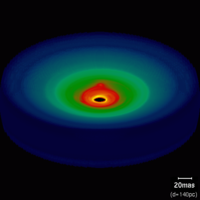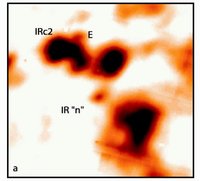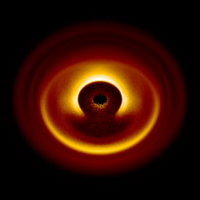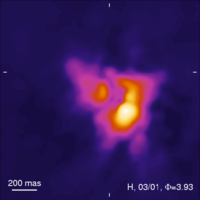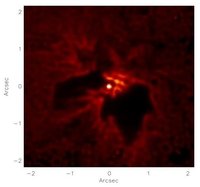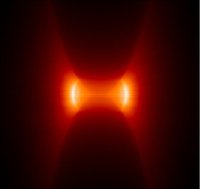MATISSE - the Multi AperTure Mid-Infrared SpectroScopic Experiment - is foreseen as a mid-infrared spectro-interferometer combining the beams of up to 4 UTs/ATs of the Very Large Telescope Interferometer (VLTI).
MATISSE will measure closure phase relations and thus for the very first time allow image reconstruction on angular scales of 10-20 mas. Thus, MATISSE will extend the astrophysical potential of the VLTI by overcoming the ambiguities often existing in the interpretation of simple visibility measurements. In addition to the N band, MATISSE will open three new observing windows for high-resolution imaging and spectroscopy at the VLTI: the L, M, and Q band which all belong to the mid-infrared domain. Thus, MATISSE will Trace regions with different characteristic temperatures (e.g., N band: 200-400K vs. Q band: 100-200 K). The physical conditions and chemical environment can therefore be studied in different regions (e.g., in proto-planetary disks, or stellar winds) Provide images with different spatial resolution (according to the linear dependence of the spatial resolution on the observing wavelength). Allow a comparison with lower-resolution images obtained at large telescopes with adaptive optics - tracing the large-scale structure of the scientific targets - in different wavelength regions (e.g., L/M band: NACO/VLT; N/Q band: VISIR/VLT). Moreover, MATISSE will offer the possibility to perform simultaneous observations in separate bands.
MATISSE will allow one to perform interferometric spectroscopy with different spectroscopic resolutions in the range of R 30-1000. In particular, the spectral resolutions are considered which allow to investigate amorphous dust features, crystalline dust features, emission features of Polycylic Aromatic Hydrocarbons, and - in its highest spectroscopc resolution - even molecular bands. These higher spectral resolutions will allow a fundamental analysis of the composition of gases and dust grains in various environments. Depending on the individual observing band, unique, new spectral features of dust/gas are accessible. In addition, spectral features that correspond to dust/gas species which can also be observed in N band. Observations in additional bands would therefore for example allow to disentangle the many ambiguities existing in the interpretation of the N band silicate feature. In summary, MATISSE can be seen as a successor of MIDI at the VLTI by providing imaging capabilities in the entire mid-infrared accessible from the ground. The extension of MATISSE down to 2.7 µm as well as its generalisation of the use of closure phases make it also a successor of AMBER. Thus, in many respects MATISSE will combine and extend the experience acquired with two first generation VLTI instruments - MIDI and AMBER. In terms of image capability MATISSE can be seen as a ground precursor of the future space interferometer Darwin which is presently studied as an instrument sensitive to the 6 to 18 µm range.
In most astrophysical domains which require a multi-wavelength approach, MATISSE will be a perfect complement of forthcoming international high angular resolution facilities such as ALMA (the Atacama Large Millimeter Array). MATISSE covers the mid-infrared spectral domain, between the near-infrared domain, for which many interferometric facilities are developed, and ALMA which will operate at (sub)millimeter wavelengths. With the extended wavelength coverage from the M to the Q band, MATISSE will not only allow one to trace different spatial regions of the targeted objects, but also different physical processes and thus provide insights into previously unexplored areas (such as the investigation of the distribution of volatiles in addition to that of the dust).
|
Image: Wolf & Klahr 2005 |
The Circumstellar Environment of Young Low- and Intermediate Mass Stars
|
|
|
The Formation of Massive StarsResolve the innermost regions of massive star-forming cores, disentangle the spatial fine structures, reveal multiplicity beyond binarity for the central massive objects, find potential low-mass YSO halos around the young massive stars. Search for potential disks around young massive stars, reveal the spatial structures in those disks, resolve the inner disk region where the actual mass transfer onto the forming star occurs. |
|
Image: Rodmann & Wolf 2006 |
Resolving the planetary regions of exo-zodiacal dust disks |
Extrasolar PlanetsMATISSE has the potential to detect extrasolar giant planets with differential interferometry. Differential interferometry will allow to achieve an equivalent increase of the spatial resolution information of a factor of 10. It will generate a relative astrometric measurements between the images at different wavelengths. In the case of an observation of a source with multiple components like a binary or a star plus a planet for instance, for which a simple model of the source can be supposed, we expect that the differential method will give access to the measurements of very high contrast between the components or of very highly contrasted components. By this way the possibility of observing "hot Jupiter"-like planets will be studied. The L and the M band yield potentially the best possible ratio between the signal expected from a Pegasi planet and the error resulting from the still relatively limited background. The L and M flux ratios yields a much better constraint on the temperature for example. |
|
|
|
Dust and Winds from Evolved Stars
Since the interplay between stellar pulsations (probed by the gas-phase molecular diagnostics in the MATISSE spectral region) and dust formation (probed by the dust diagnotics accessible to MATISSE) is of key importance, simultaneous observations at thermal IR wavelengths is essential. |
|
|
The Environment of Hot Stars
|
|
|
Active Galactic Nuclei
|
last changes: Oct 16, 2006 Sebastian Wolf, Laszlo Mosoni



